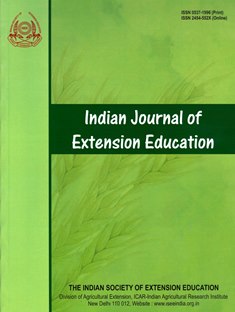Barriers to Handicraft Development in Rural Saravan, Iran: A Bayesian Network and Fuzzy AHP Analysis
DOI:
https://doi.org/10.48165/IJEE.2025.61401Keywords:
Barriers, Bayesian network, Fuzzy AHP, Governance, Handicrafts, Rural economy, IranAbstract
The study examined the key barriers hindering the development of the handicraft sector in Saravan, Iran, with a focus on identifying their significance and interrelationships. Despite the global recognition of Saravan’s Kalporagan pottery, a 7,000-year-old tradition preserved by local women, the region’s handicraft industry has faced persistent stagnation. A mixed method approach was adopted, utilizing the Fuzzy Analytical Hierarchy Process (FAHP) to categorize barriers into six main groups: managerial, motivational-psychological, marketing and sales, financial-economic, skill-technical, and product-based. This study was conducted in 2024. The findings showed that managerial barriers were the most critical, followed by motivational and marketing challenges, while product-related barriers had the least impact. To explore causal connections among these barriers, Bayesian Network Analysis (BNA) was applied, revealing that managerial shortcomings significantly influenced financial and marketing constraints. The study concluded that addressing managerial inefficiencies could alleviate other development obstacles. It emphasized the need for targeted institutional reforms, investment in tourism infrastructure, and improved market access to revitalize Saravan’s handicrafts and contribute to sustainable rural development.
Downloads
References
Agarwal, V., Mathiyazhagan, K., Malhotra, S., & Pimpunchat, B. (2022). Building resilience for sustainability of MSMEs post COVID-19 outbreak: An Indian handicraft industry outlook. Socio-economic Planning Sciences, 101443. Advance online publication. https://doi.org/10.1016/j.seps.2022.101443
Agrahari, R., Foroushani, A., Docking, T. R., & others. (2018). Applications of Bayesian network models in predicting types of hematological malignancies. Scientific Reports, 8, 6951. https://doi.org/10.1038/s41598-018-24758-5
Akbari, M., Gholamzadeh, R., & Arasti, Z. (2015). Entrepreneurship training needs of rural youth to set up businesses in rural handicrafts. Journal of Rural Research, 6(2), 299–322. https://doi.org/10.22059/jrur.2015.54909
Bakhtiari, P. (2019, July 20). Kalporagan Village: World’s only living pottery museum. Surfiran. https://surfiran.com/mag/kalpourgan-village-worlds-only-living-pottery-museum/
Chandre Gowda, M. J., Bindu, H. A., & Sai Tejashree, G. (2025). Breaking the barriers of farm income through supplementary enterprises: A step beyond farming systems. Indian Journal of Extension Education, 61(2), 19–24. https://doi.org/10.48165/IJEE.2025.61204
Chang, D. Y. (1996). Applications of the extent analysis method on fuzzy AHP. European Journal of Operational Research, 95(3), 649–655. https://doi.org/10.1016/0377-2217(95)00300-2
Journeault, M., Perron, A., & Vallières, L. (2021). The collaborative roles of stakeholders in supporting the adoption of sustainability in SMEs. Journal of Environmental Management, 287, 112349. https://doi.org/10.1016/j.jenvman.2021.112349
Kademani, S., Nain, M. S., Singh, R., Kumar, S., Parsad, R., Sharma, D. K., Roy, S. K., Krishna, D. K., Prabhakar, I., Mahapatra, A., & Patil, M. (2024). Unveiling challenges and strategizing solutions for sustainable agri-entrepreneurship development. Frontiers in Sustainable Food Systems, 8, 1447371. https://doi.org/10.3389/fsufs.2024.1447371
Karbasi, A., & Yaqoubi, M. (2018). A study of handicraft cooperatives market in Sistan and Baluchistan province. Cooperative and Agriculture, 22(5), 21–46.
Karimzadeh, M. (2019). The obstacles of entrepreneurship for Baluch women in Saravan district. Women’s Studies Sociological and Psychological, 17(2), 7–34. https://doi.org/10.22051/jwsps.2019.17093.1560
Karimzadeh, M. (2022). Investigating and prioritising rural development barriers in Iran: Case study of Saravan. Journal of Rural Development, 40(4), 581–600. https://doi.org/10.25175/jrd/2021/v40/i4/144465
Karimzadeh, M., Dehvari, F., & Zareh, M. (2016). Investigation of the role of Saravan handicrafts in entrepreneurship and job creation to attract tourism. Proceedings of the National Conference on Eastern Development Strategies of Iran, Zahedan.
Kobba, F., Nain, M. S., Singh, R., Mishra, J. R., & Shitu, G. A. (2020). Observational analysis of the effectiveness of entrepreneurship training programme in rural development and self-employment training institutes (RUDSETI). Indian Journal of Extension Education, 56(1), 13–17.
Makhitha, K. M. (2016). Marketing strategies of small craft producers in South Africa: Practices and challenges. The Journal of Applied Business Research, 32(3), 663–680. https://doi.org/10.19030/jabr.v32i3.9649
Makhitha, K. M. (2017). Challenges affecting small craft producer business growth and survival in South Africa. Journal of Business and Retail Management Research, 11(3), 1–12.
Mohapatra, S. H. (2013). Problems of weavers cooperative societies in Odisha – A critical analysis. Indian Journal of Extension Education, 49(3&4), 90–95.
Nain, M. S., Singh, R., Mishra, J. R., Sharma, J. P., Singh, A. K., Kumar, A., Gills, R., & Suman, R. S. (2019). Maximising farm profitability through entrepreneurship development and farmers’ innovations: Feasibility analysis and action interventions. Indian Journal of Agricultural Sciences, 89(6), 1044–1049. https://doi.org/10.56093/ijas.v89i6.90833
Omidi, N., Omidi, M. R., & Mohammadi, E. (2016). Identify and assess the barriers to the development of the local market handicrafts Ilam. A Scientific Journal of Ilam Culture, 16(48–49), 132–146.
Paidar, A. (2016). Identify and prioritize the determinants of flourishing handicrafts Baluch (Case study: Rural areas in Qasr-e Qand County). Journal of Research and Rural Planning, 5(3), 215–229. https://doi.org/10.22067/jrrp.v5i3.53952
Rahayu, M., Sunarti, S., Rugayah, Sulistiarini, D., Keim, A. P., Nikmatullah, M., & Sujarwo, W. (2024). Overview of the handicraft products of Lepironia articulata (Retz.) Domin (Cyperaceae) in Wawonii Island, Southeast Sulawesi, Indonesia. Indian Journal of Traditional Knowledge, 23(9), 862–868. https://doi.org/10.56042/ijtk.v23i9.557
Saaty, T. L. (1990). How to make a decision: The Analytic Hierarchy Process. European Journal of Operational Research, 48(1), 9–26. https://doi.org/10.1016/0377-2217(90)90057-I
Shabani Afarani, E., Shahzeidi, M., & Kiani Babukani, A. (2022). Identifying the problems of handicrafts cooperatives: A qualitative study in Isfahan City. Journal of Economic & Developmental Sociology, 11(2), 145–168. https://doi.org/10.22034/jeds.2023.51704.1656
Shah, A., & Patel, R. (2017). Problems and challenges faced by handicraft artisans. Voice of Research, 6(1), 57–61.
Shams al-Dini, A. (2020). Analyzing the obstacles to the entry of handicraft cooperative companies of Fars Province to the world markets. Quarterly Journal of Development Strategy, 62(16), 47–77.
Sharma, R., & Ranjan, J. (2024). Challenges and problems faced by the Indian handloom and handicraft industry. International Journal of Management Issues and Research, 13(1), 133–145. https://doi.org/10.69711/sharda.ijmir.v13i1.2410
Downloads
Published
Issue
Section
License

This work is licensed under a Creative Commons Attribution-NonCommercial-NoDerivatives 4.0 International License.

